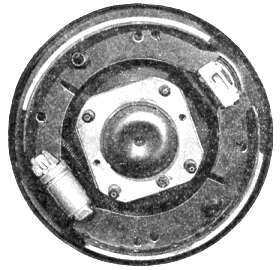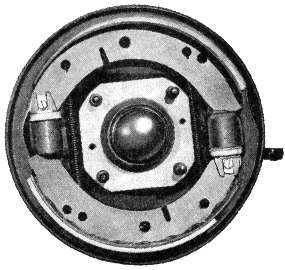The MGA With An Attitude
HOW DRUM BRAKES WORK - BT-121
Once again an innocent question generates some profound thought, informative but perhaps a bit boring.
On 9/7/2010, Tom Price in Annapolis, Maryland, wrote:
"Which hole in the brake shoe does the spring go in"?
Front and rear springs are different. Front springs stretch longer at a slight angle, anchoring in the hole farther from the end of the shoe. Rear springs (two different sizes) are symmetrical (at right angles to the mounting axis of the shoes), anchoring in the hole nearest the end of the shoe. Do it as described in the book. The short story here is that you do not need to know how or why it works to get it right if you just do it as noted. However, I always figure if you understand how it works you can get it right without having to look in the book.


Rear drum brakes, right side - - - Front drum brakes, right side
Drum rotation is clockwise for forward travel.
Why it was done this way is a bit to comprehend, almost like black magic. I will take a stab at a LONG explanation. It has to do with the front brakes having two fixed slave cylinders and two leading shoes, while the rear brakes have one floating slave cylinder, one leading shoe and one trailing shoe (even though all of the shoes are the same part number).
Consider that the shoes have a pivot end (at the anchor point) and an actuated end (pushed by the slave cylinder). "Leading shoe" may be defined as having the actuator end come first in the direction of rotation. "Trailing shoe" may be defined as having the actuator end come last in the direction of rotation. Leading shoes are self energizing (in the forward direction of rotation). This is because friction force at the shoe to drum interface causes the shoe to be driven into the drum with more force than is applied by the slave cylinder alone. Trailing shoes are self de-energizing, as friction force at the shoe to drum interface causes the shoe to be driven slightly away from the drum to counter some of the force applied by the slave cylinder. Front drum brakes have two leading shoes that will be most effective when the car is moving in forward motion. Rear drum brakes have one leading and one trailing shoe and will work equally well in either direction.
Front brakes may also have larger bore slave cylinders to apply more force to the shoes than at the rear. It is important that front brakes have more force and do more of the braking work. Even when the car may have close to 50/50 front to rear weight distribution, during hard forward braking some weight is transferred from rear to front. This is due to center of gravity of the car being above ground level while tire to road friction is at ground level. Hard braking deceleration causes a forward inertial force at the center of gravity while road friction on the tires causes an equal and opposite rearward force at ground level. Distance between these two forces causes a rotational force on the car that drives the nose downward while the tail is lifted by an equal force. When the front axle is carrying more weight it needs more braking force. Perhaps more to the point, the rear axle needs lower braking force to prevent the rear wheels from locking up and tires skidding. While using the same size drums and shoes on front and rear, the rear braking force can be reduced by using one trailing shoe and a smaller bore slave cylinder.
This is often referred to as "brake balance". The idea is to apply proportional braking force front and rear to the point where all tires might break loose and skid at about the same time. If brakes at either end of the car lock up early you have to reduce pedal pressure to avoid the lock up condition, and that reduces braking effect and increases stopping distance. Getting the balance right will reward you with best braking and shortest stopping distance. If front wheels lock up first the car goes straight forward. If the rear wheels lock up first the car may quickly change ends to go tail first or spin out. Given a choice for safety sake it is therefore preferable that the rear wheels should never lock up before the front wheels, so brake balance is commonly biased a little stronger toward the front end.
When backing up at some speed and doing hard braking, all of the opposite happens. There will be some front to rear weight transfer, so more weight on the rear axle wanting more braking force at the rear. Going this direction you still have one leading and one trailing shoe in the rear, but now have two trailing shoes in the front. Double trailing shoes reduces braking force on the front wheels rather dramatically, which in turn should keep the front wheels from locking up and tires skidding. An additional result of all this is that the front drum brakes are far less effective when traveling in reverse, so it will require higher pedal force to stop the car. If you stand on the pedal hard enough it will still stop effectively, but many drivers may be taken by surprise with this effect and immediately claim that the brakes don't work as well in reverse. The brakes really do work as well in reverse and can lock up all four wheels at about the same time, but it requires more pedal force to make it happen. Most people are not much affected by this issue as they seldom drive vigorously in reverse.
Getting back to those pesky springs, it may be easier to understand in the rear. When you have one leading and one trailing shoe the brakes work much the same in either direction, so the springs want to attach the same at both ends to be symmetrical. This need may override some logic used on the front brakes.
On the front the primary concern is for most effective operation of two leading shoes going in the forward direction. Stretching the spring more to the farther reach mounting hole will give the spring more tension. This difference in tension may be about proportional to the working area of the piston in the larger bore front slave cylinder vs. the smaller bore rear slave cylinder. This in turn would apply about the same small hydraulic pressure inside the cylinders to give similar effective return action for the shoes when brakes are released (not that it makes much functional difference in the real world).
A side effect of attaching the springs at a 5 degree angle (or there about) from the normal direction of forces could be to create a small force vector (couple of pounds) that would tend to slide the shoes in the direction of the anchor end (trailing end of the front shoes in the forward direction). The shoes will be self centering each time brakes are applied. When at rest for long periods of travel time some vibration may cause the shoes to slide and run with the trailing end in light contact with the drum. This is apparently not any functional problem (if it happens at all).
|